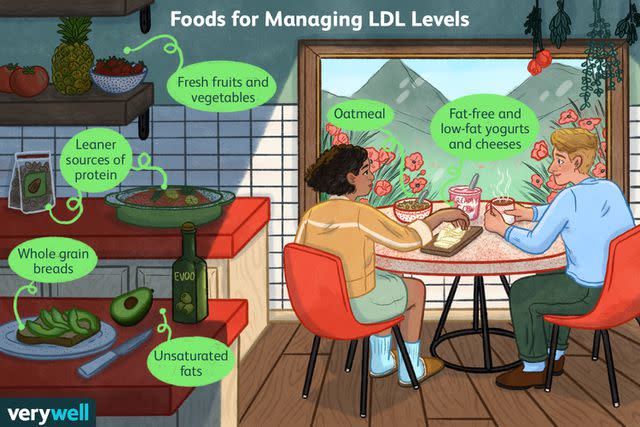What Causes High LDL?
Many factors can cause elevated levels of "bad" cholesterol

LAartist/Getty Images
Medically reviewed by Jeffrey S. Lander, MD
A lot of factors can cause your low-density lipoprotein (LDL) cholesterol to be high, including genetics, being overweight, diet, and more.
In this article, you'll learn what cholesterol levels are considered healthy versus high, how they're measured, and how various contributing factors increase your levels.

Verywell / Brianna Gilmartin
What is High LDL?
LDL is a lipoprotein—a fat-like substance that carries cholesterol to cells. Optimal LDL cholesterol levels are below 100 milligrams per deciliter (mg/dL). Anything over 160 mg/dL is considered high, and an LDL levels of 190 mg/dL and up is dangerously high.
When you have too much LDL cholesterol in your blood, it can build up and clog arteries. This can lead to health problems such as coronary artery disease (CAD), heart attack, peripheral artery disease, and stroke.
High LDL cholesterol has no warning signs or symptoms. The first sign can be a blood clot, heart attack, or stroke. That's why it's important to regularly have your cholesterol levels tested.
The higher your LDL level, the more important it is to take steps to lower it. People with diagnosed cardiovascular disease should aim for an LDL level below 70 mg/dL.
LDL Levels | Age | Range (mg/dL) |
Optimal | Under 20 | Under 110 |
Near-Optimal | Under 20 | * |
Borderline | Under 20 | 110-129 |
High | Under 20 | 130-Up |
Very High | Under 20 | * |
What Can Cause High LDL?
Several factors can raise your LDL cholesterol. High LDL cholesterol can be due to diet, genetics, a lack of exercise, or a side effect of medication.
Unhealthy Diet
What you eat can have a big impact on your LDL levels. In particular, two types of fat—saturated fat and trans fats—can cause high LDL cholesterol. These are fats that are solid at room temperature.
According to the American Heart Association, saturated fat should make up only about 5% of your daily calories. Foods high in saturated fat should be eaten sparingly and include:
Bacon
Baked goods
Beef and beef fat
Butter
Cheese made from whole milk
Chicken with the skin on
Cream
Deli meats, including roast beef and turkey
Full-fat dairy
Ham
Lamb
Lard
Palm oils
Pork
Processed meats, like beef jerky, hot dogs, pepperoni, and sausage
Red meats
Whole-fat milk
Trans fats, a type of manufactured fat, are polyunsaturated fats that have been altered from a liquid oil to a solid fat through a chemical process called hydrogenation.
Trans fats are listed on the nutrition facts label on food packaging and can be found in:
Anything battered and fried
Commercially baked cakes, pies, and cookies
Fast foods
Refrigerated dough
Partially hydrogenated vegetable oils
Shortening
Stick margarine
Added sugar or corn syrup can also raise LDL, so avoid them. Read labels, as these can be in surprising places.
Some foods can help you lower high LDL levels or maintain healthy levels. For example, eating unsaturated fats can help reduce LDL cholesterol levels while raising HDL.
Heart-healthy foods to enjoy include:
High-fiber foods: Leafy vegetables, oatmeal, beans, and apples
Lean proteins: Fish, skinless chicken, nuts, beans, fat-free or low-fat milk
Low-fat foods: Fresh vegetables and fruits, whole grain bread, fat-free or low-fat yogurts, and cheeses
Unsaturated fats: Avocados, nuts, and olive oil
Being Obese or Overweight
Another major risk factor for high LDL is carrying excess body weight. It limits your body’s ability to remove this type of cholesterol from the bloodstream and is directly related to higher levels.
The most commonly used measure to evaluate weight is the body mass index (BMI). It uses weight and height to estimate body fat. The resulting number is then used to categorize people as:
Underweight
Normal weight
Overweight
Obese
Morbidly obese
But BMI is not perfect. It doesn't account for other factors that determine body composition, like age, muscle mass, or sex. BMI calculations may, for example, overestimate body fat in athletes or in older people.
Even so, higher BMI scores should be addressed. Research has shown that even a modest reduction in weight—say, 5% to 10% of the starting figure—lowers LDL and reduces other cardiovascular risk factors.
Lack of Physical Exercise
Low physical activity can also drive LDL higher. Even modest increases in exercise can help a great deal.
Your healthcare provider may suggest up to 90 minutes of physical activity a day, but even 30 to 45 minutes on a regular basis can be helpful.
At a bare minimum, most guidelines recommend that adults get 2.5 hours of moderate exercise every week. This can include:
Biking
Brisk walking
Jogging
Swimming
Tobacco and Alcohol
Among the many negative health effects of smoking/using tobacco are the following:
Atherosclerosis
Elevated LDL
Lower HDL levels
Quitting this habit, or not starting, goes a long way in managing cholesterol and reducing your risk of heart disease and cancer.
Second-hand smoke—inhaling someone else's tobacco smoke—is linked with many of the same health problems. If you’re a smoker, smoke outside and away from nonsmokers. If you’re not a smoker, try to avoid second-hand smoke.
Also, because of its many effects on the body, excessive alcohol consumption and alcoholism are linked with higher cholesterol levels. Limiting your drinking or stopping altogether can help you manage your levels.
If you want to quit smoking or drinking but are struggling with the addiction, talk to your healthcare provider about things that may help you stop.
Learn More:What Is Alcohol Use Disorder?
Age and Sex
Your age and sex can also have a significant influence on LDL levels. As people age, they usually rise.
Between the ages of 20 and 59, people assigned male at birth (AMAB) tend to have higher LDL levels than people assigned female at birth (AFAB). In contrast, people who were AFAB and over 60 typically have higher LDL values than those who were AMAB.
Menopause can also raise your risk of high LDL cholesterol. More frequent LDL monitoring is recommended when you're post-menopausal.
Genetics
As with many health conditions, a family history of high cholesterol increases the risk of your developing it.
One in every 500 people has a genetic condition called familial hypercholesterolemia (FH) that leads to high LDL levels. This condition is especially concerning because it's often undetected and is tied to early heart attacks, strokes, and deaths.
In FH, a gene that's essential for clearing LDL cholesterol from the bloodstream malfunctions. That's due to faulty receptor proteins.
If you only get this gene from one parent (heterogenous FH), about half of these proteins don't work. If you get one from each parent, it's called homogenous, and the disease is more severe, as none of the proteins work.
If any of your family members have tough-to-treat high cholesterol, or you have a family history of heart disease, you may want to get genetic screening for FH.
Ethnicity
According to a growing body of research, ethnicity is a factor in high cholesterol levels. While people of any ethnicity can develop high LDL, the risk varies by ancestry and sex:
Race | Males | Females |
Black | 9.2% | 10.5% |
Hispanic | 12.4% | 9.2% |
Asian | 13% | 10.3% |
White | 10.1% | 12.1% |
Medications
Some prescription medications can also cause an elevated LDL level. You and your healthcare provider should weigh the risks and benefits of these drugs while considering your personal and family medical history.
The following classes of drugs can raise LDL levels.
Heart Disease and Blood Pressure Drugs
Drugs for heart conditions and high blood pressure can increase LDL levels. That makes managing your cholesterol levels both harder and more important. Classes of drugs that do this include:
Loop diuretics: Bumex (bumetanide), Edecrin (ethacrynic acid)
Thiazide diuretics: Zaroxolyn (metalozone), Lozol (indapamide)
Sodium-glucose cotransporter 2 (SGLT2) inhibitors: Invokana (canagliflozin), Farxiga (dapagliflozin)
Steroids
These powerful anti-inflammatory medications can boost your cholesterol. Drugs in this category include:
Danocrine (danazol)
Anabolic steroids (synthesized testosterone)
Some corticosteroids like Prednisone Intensol (prednisone) and Orapred (prednisolone)
Antiviral Drugs
Antiviral medications for HIV/AIDS and hepatitis C can be a problem as well. These include protease inhibitors such as:
Viracept (nelfinavir)
Incivek (telaprevir)
Harvoni (ledipasvir)
Fuzeon (enfuvirtide)
Immunosuppressants
Some immunosuppressant drugs, which are used to prevent rejection after organ transplants, may be a problem when it comes to LDL levels. That's especially true of:
Cyclosporine
Tacrolimus
Nervous System Drugs
Some drugs that act on the brain and central nervous system (CNS) may directly affect LDL. These include anticonvulsant drugs for epilepsy and other conditions, including:
Other Health Conditions That Make LDL Cholesterol High
High cholesterol can also be caused by a range of other health conditions you may have. These include:
Type 2 diabetes: Insufficient insulin production limits your body’s ability to process LDL.
Liver disease: The liver helps clear cholesterol, so when it's impaired, levels may rise.
Kidney diseases: The kidneys also play a central role in cleaning out your bloodstream, so problems such as chronic kidney disease can increase cholesterol levels.
Pregnancy: Changes in the body during pregnancy often make cholesterol levels rise, which increases the risk of preeclampsia and eclampsia, two dangerous complications.
Hypothyroidism: Low thyroid activity also interferes with LDL levels, enough so that high LDL often leads to thyroid testing.
Summary
LDL is considered "bad" cholesterol because too-high levels can lead to atherosclerosis in the arteries and contribute to problems like heart attack and stroke. Some factors that raise LDL levels cannot be changed, such as age, ethnicity, and genetics.
However, other factors are modifiable and can help you treat high LDL. These include lifestyle habits like diet, exercise, and smoking. Changing these factors is usually the first step toward lowering LDL.

